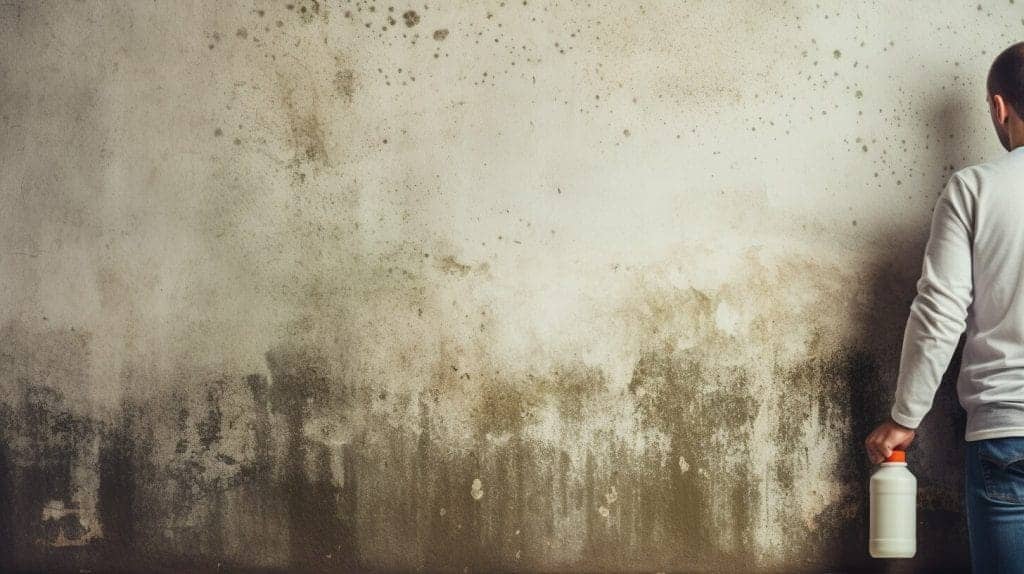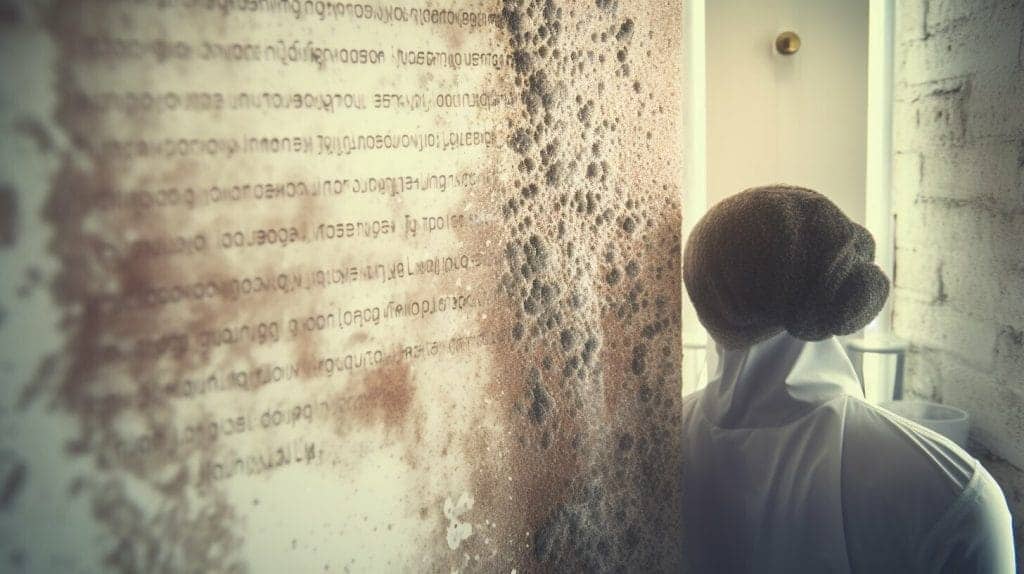Welcome to our article about black mold in showers and the health risks it poses. If you’ve noticed black mold in your shower, you may be wondering if it is safe to use and what health risks you and your family are exposed to. In this article, we will cover everything you need to know about black mold in showers, including the health risks, prevention methods, and cleaning techniques. So, is black mold in shower dangerous? Let’s find out.
What is Black Mold and How Does it Form in Showers?
Black mold, also known as Stachybotrys chartarum, is a type of mold that thrives in damp and humid environments. Due to the moisture present in bathrooms, black mold is a common problem in shower areas. Shower surfaces such as tiles and grout are porous and can absorb water easily, providing an ideal environment for mold growth.
Black mold is not the only type of mold that can grow in bathrooms. Other types of mold commonly found in showers include Aspergillus, Penicillium, and Cladosporium. These molds can also pose health risks to humans if not properly cleaned and removed.
The primary cause of black mold growth in showers is moisture and humidity. Lack of proper ventilation and cleanliness can also contribute to mold growth. If left unchecked, mold can spread quickly and affect other areas of the bathroom and home.
Health Risks of Black Mold in Shower
Black mold in showers can pose several health risks to humans, particularly those with weak immune systems or underlying respiratory conditions. It can cause respiratory problems, allergies, and skin irritation.
When inhaled, black mold spores can cause a range of adverse effects on human health, including coughing, wheezing, and sneezing. Some individuals may experience more severe reactions, such as asthma attacks or fungal infections.
Exposure to black mold can also lead to skin irritation and allergies, causing rashes, hives, and other skin problems. The longer the exposure, the worse the symptoms can become.
Individuals with weakened immune systems, such as cancer patients undergoing chemotherapy or those with HIV/AIDS, are particularly susceptible to the adverse effects of black mold exposure. Prolonged exposure to mold spores can lead to serious fungal infections, which can be life-threatening in some cases.
To prevent these health risks, it is crucial to take necessary measures to prevent and remove black mold growth in showers.
Prevention of Black Mold Growth in Shower
Preventing black mold growth in your shower requires consistent and proactive efforts to keep it clean and dry. Here are a few tips to help you prevent mold growth:
| Prevention Method | Description |
|---|---|
| Proper ventilation | Make sure your bathroom has adequate ventilation to reduce moisture. Use an exhaust fan or open a window while showering and for at least 30 minutes after to allow moisture to escape. |
| Regular cleaning | Regularly clean your shower area with a mold and mildew cleaner, paying special attention to the grout lines and corners. |
| Dry shower after use | Use a squeegee or towel to dry the shower area after each use to remove excess moisture. |
| Repair leaky faucets or fixtures | Fix any leaks in your shower to prevent excess moisture buildup. |
Risks of Showering with Black Mold
Showering with black mold can cause respiratory problems and allergies, among other health issues. Inhaling the spores can cause coughing, sneezing, wheezing, and other respiratory problems. People with allergies may experience allergic reactions such as itchy eyes, runny nose, and skin irritation.
Additionally, black mold in the shower can exacerbate asthma symptoms and cause long-term damage to the respiratory system.
How to Prevent Health Risks from Black Mold in Shower?
The best way to prevent health risks from black mold in the shower is to prevent mold growth in the first place. Follow the prevention tips mentioned above and make sure to clean any visible mold as soon as possible. If you experience any symptoms related to mold exposure, such as coughing, wheezing, or skin irritation, seek medical attention immediately.
Cleaning and Removing Black Mold from Shower
When it comes to removing black mold from your shower, it is important to take all necessary precautions to ensure you do not inhale the spores. Wear protective gloves, a mask and use goggles to cover your eyes.
You will need some basic supplies to clean the black mold. These include:
- Bucket
- Sponge
- Scrub brush
- Bleach
- Vinegar
- Baking soda
- Water
Clean the shower with a mixture of bleach and water. Scrub the affected areas with the sponge and brush to get rid of the mold. Rinse the shower with clean water and dry it with a towel.
If you would rather use a natural method, vinegar and baking soda can be used to clean the mold. Mix vinegar and water in equal parts and spray the solution onto the mold. After a few minutes, sprinkle baking soda onto the affected area and scrub with the brush. Rinse the shower with clean water and dry it with a towel.
It is essential to tackle black mold as soon as you notice it. Early prevention and treatment can save you a lot of trouble and money in the long run. In cases where the mold is too severe or has spread to other areas, it is best to call a professional for mold removal services.
When to Call a Professional for Mold Removal
In most cases, it is possible to clean and remove black mold from your shower using the proper tools and techniques. However, there are situations where it is best to call a professional mold removal service.
If you have a large amount of mold, or if the mold growth extends beyond the shower and into other areas of your home, it is best to seek professional help. Additionally, if you have underlying health conditions or if you are experiencing severe symptoms related to mold exposure, it is best to have the mold removed by a professional.
Professional mold removal services have the necessary equipment and expertise to safely remove mold from your home. They can also identify the underlying cause of the mold growth and take steps to prevent future mold issues.
When to Call a Professional for Mold Removal:
| Situation | Action required |
|---|---|
| You have a large amount of mold in your shower. | Seek professional mold removal services. |
| The mold growth extends beyond the shower and into other areas of your home. | Seek professional mold removal services. |
| You have underlying health conditions or are experiencing severe symptoms related to mold exposure. | Seek professional mold removal services. |
Professional mold removal services can be costly, but the long-term benefits of having a mold-free and safe home are worth it. Safety should always be your top priority, so don’t hesitate to call a professional if you feel uncertain about cleaning the mold yourself.
Tips on Keeping Your Shower Mold-Free
Preventing black mold growth in your shower is crucial for maintaining a healthy environment in your home. Here are some additional tips and tricks to keep your shower mold-free:
- Make sure your shower is properly ventilated by using an exhaust fan or opening windows after showering to allow moisture to escape.
- Use a squeegee or towel to wipe down the walls and floors of your shower after each use to remove excess water.
- Regularly clean your shower with a mold and mildew remover. Be sure to follow the product instructions and wear gloves and eye protection while cleaning.
- Replace old or damaged caulk and grout around your shower to prevent water from seeping into crevices.
- Fix any leaks or water damage in your bathroom as soon as possible to avoid creating a damp environment that promotes mold growth.
- Consider using a dehumidifier in your bathroom to reduce moisture in the air.
By following these tips, you can significantly reduce the risk of black mold growth in your shower and maintain a clean and healthy bathroom environment.
Other Areas of the Home Prone to Black Mold Growth.
While showers are a common area for black mold growth, there are other areas of your home that can be affected as well. Mold thrives in warm and damp environments, so it’s important to keep an eye on areas that are prone to moisture.
Here are some other areas where mold growth is common:
| Area | Cause of Moisture |
|---|---|
| Basements | High humidity levels, water leaks or seepage |
| Attics | Poor ventilation, roof leaks |
| Kitchens | Steam from cooking, leaky pipes, and faucets |
Regular cleaning and maintenance can help prevent mold growth in these areas. If you notice water damage or suspect mold growth, it’s important to take action as soon as possible to prevent the problem from worsening.
The Importance of Regular Home Inspections
Regular home inspections are essential to detect mold growth in your shower and other areas of your home. They can help you identify a mold problem before it becomes a health hazard and reduce the risk of costly property damage.
A thorough inspection should be performed by a professional mold inspector who has experience in identifying mold and moisture problems. They will check areas such as your attic, basement, and crawl space and look for any visible signs of mold or water damage. They will also check for any sources of increased humidity or moisture, such as leaky pipes or poor ventilation.
If you suspect that you have mold growth in your shower or other areas of your home, consider scheduling a mold inspection. It is best to do this as soon as possible to avoid any potential health hazards and costly repairs.
Common Misconceptions About Black Mold in Showers.
There are many misconceptions about black mold in showers that can lead to health risks if not addressed. Here are some of the most common:
- Myth: Bleach can kill black mold in showers.
Fact: While bleach can temporarily remove visible mold, it does not kill the spores that can grow again. It is best to use a mold-specific cleaner and follow up with preventive measures to avoid future growth. - Myth: Black mold only grows in damp areas.
Fact: While moisture is a common trigger, black mold can grow in any area with high humidity levels, such as bathrooms and kitchens. - Myth: You can remove black mold in showers with vinegar.
Fact: Vinegar can remove some types of mold but might not work on black mold. It is best to use a mold-specific cleaner or seek professional help. - Myth: Installing a shower curtain will prevent black mold growth in your shower.
Fact: Shower curtains and liners can trap moisture and promote mold growth. Regular cleaning and maintenance are still necessary to keep your shower mold-free. - Myth: Black mold in showers is not dangerous.
Fact: Black mold in showers can pose serious health risks and cause respiratory problems, allergies, and skin irritation.
It is crucial to address black mold growth in showers and take preventive measures to avoid future growth. It is best to rely on mold-specific cleaners or seek professional help for safe and effective removal.
Frequently Asked Questions (FAQs) About Black Mold in Showers
Black mold in showers is a common problem that affects many households. It not only ruins the appearance of your shower but also poses health risks to you and your family. Below are some frequently asked questions about black mold in showers.
Is black mold in showers dangerous?
Yes, black mold in showers can be dangerous. It can cause respiratory problems, skin irritation, and allergies. Black mold releases spores that can trigger asthma attacks and other respiratory problems, especially in people with weakened immune systems.
What are the health risks of black mold in showers?
The health risks of black mold in showers can range from minor skin irritation to more severe respiratory problems. Prolonged exposure to black mold can cause allergic reactions, coughing, and wheezing. In some cases, black mold can cause lung infections and asthma attacks.
How can I prevent black mold in my shower?
You can prevent black mold in your shower by reducing moisture and humidity levels, improving ventilation, and keeping the area clean and dry. Make sure to wipe down your shower after each use and use a fan or dehumidifier to reduce humidity levels in the bathroom.
How do I clean and remove black mold from my shower?
You can clean and remove black mold from your shower using a solution of bleach and water, vinegar, or hydrogen peroxide. Make sure to wear gloves and a mask to protect yourself from the spores. Scrub the affected area with a brush and rinse thoroughly with water. If the mold is severe, consider calling a professional mold removal service.
When should I call a professional for mold removal?
You should call a professional for mold removal if the mold covers a large area, if it keeps coming back, or if you have underlying health conditions. A professional will have the equipment and knowledge to safely remove the mold and prevent it from returning.
Can bleach kill black mold?
While bleach can kill some types of mold, it is not effective against black mold. Black mold requires specialized cleaning techniques and solutions to fully remove it.
How often should I inspect my home for mold?
You should inspect your home for mold at least once a year, but more frequently if you notice any signs of mold such as a musty odor or visible growth. Regular inspections can help you catch mold early and prevent it from spreading.
Hopefully, these FAQs have answered some of your questions about black mold in showers. Remember to take precautions to prevent mold growth and always seek professional help if you need it.
Dr. Francisco Contreras, MD is a renowned integrative medical physician with over 20 years of dedicated experience in the field of integrative medicine. As the Medical Director of the Oasis of Hope Hospital in Tijuana, Mexico, he has pioneered innovative treatments and integrative approaches that have been recognized globally for the treatment of cancer, Lyme Disease, Mold Toxicity, and chronic disease using alternative treatment modalities. Dr. Contreras holds a medical degree from the Autonomous University of Mexico in Toluca, and speciality in surgical oncology from the University of Vienna in Austria.
Under his visionary leadership, the Oasis of Hope Hospital has emerged as a leading institution, renowned for its innovative treatments and patient-centric approach for treating cancer, Lyme Disease, Mold Toxicity, Long-Haul COVID, and chronic disease. The hospital, under Dr. Contreras's guidance, has successfully treated thousands of patients, many of whom traveled from different parts of the world, seeking the unique and compassionate care the institution offers.
Dr. Contreras has contributed to numerous research papers, articles, and medical journals, solidifying his expertise in the realm of integrative medicine. His commitment to patient care and evidence-based treatments has earned him a reputation for trustworthiness and excellence. Dr. Contreras is frequently invited to speak at international conferences and has been featured on CNN, WMAR2 News, KGUN9 News, Tyent USA, and various others for his groundbreaking work. His dedication to the medical community and his patients is unwavering, making him a leading authority in the field.
Contreras has authored and co-authored several books concerning integrative therapy, cancer, Lyme Disease and heart disease prevention and chronic illness, including "The Art Science of Undermining Cancer", "The Art & Science of Undermining Cancer: Strategies to Slow, Control, Reverse", "Look Younger, Live Longer: 10 Steps to Reverse Aging and Live a Vibrant Life", "The Coming Cancer Cure Your Guide to effective alternative, conventional and integrative therapies", "Hope Medicine & Healing", "Health in the 21st Century: Will Doctors Survive?", "Healthy Heart: An alternative guide to a healthy heart", “The Hope of Living Cancer Free”, “Hope Of Living Long And Well: 10 Steps to look younger, feel better, live longer” “Fighting Cancer 20 Different Ways”, "50 Critical Cancer Answers: Your Personal Battle Plan for Beating Cancer", "To Beat . . . Or Not to Beat?", and “Dismantling Cancer.”









